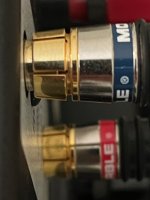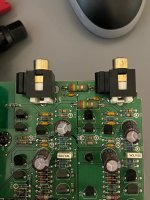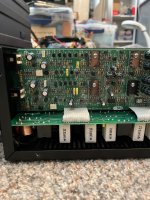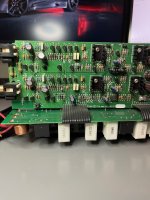You really need to get a scope picture of the problem to determine what the issue is. If it is oscillation, it’s unlikely to be caused by your electrolytic capacitors and the fact that you’ve replaced them and it’s still not working proves it. If you leave your dummy load in place but then add a small amount of capacitance in parallel with it (say 1-2nF) what happens?
As a top of my head suggestion, I’d be looking for a cracked or damaged compensation cap (will be 20-300 pF range device).
It really pisses me off when companies can’t or refuse to supply schematics. It’s an amplifier, not a piece of military gear with some secret circuit sauce. Shame on Anthem.
As a top of my head suggestion, I’d be looking for a cracked or damaged compensation cap (will be 20-300 pF range device).
It really pisses me off when companies can’t or refuse to supply schematics. It’s an amplifier, not a piece of military gear with some secret circuit sauce. Shame on Anthem.
+550000It really pisses me off when companies can’t or refuse to supply schematics. It’s an amplifier, not a piece of military gear with some secret circuit sauce. Shame on Anthem.
@huggygood - I just turned on the amp, and tried both requests and get exact same reading (nothing connected to RCAs - get 0mV DC and 1-2mV AC, same results with only one RCA plugged in)
@Bonsai that gives me a way to go, so thanks. Makes sense when you verbalize it, because I thought it was working when I tested with a dummy load, but as soom as speakers are connected, it goes haywire. Assuming this is adding the capacitance you speak of and exciting the oscillaton or "issue".
At work (boring) but will give these a try either at lunch or later this afternoon. Thanks guys
I agree as well, that a schematic for a ~20-yr old product is not out of the question, I would hope they have updated the design in that time.
@Bonsai that gives me a way to go, so thanks. Makes sense when you verbalize it, because I thought it was working when I tested with a dummy load, but as soom as speakers are connected, it goes haywire. Assuming this is adding the capacitance you speak of and exciting the oscillaton or "issue".
At work (boring) but will give these a try either at lunch or later this afternoon. Thanks guys
I agree as well, that a schematic for a ~20-yr old product is not out of the question, I would hope they have updated the design in that time.
It’s true that it’s getting annoying.I just turned on the amp, and tried both requests and get exact same reading (nothing connected to RCAs - get 0mV DC and 1-2mV AC, same results with only one RCA plugged in)
But given the competent people here, there's a good chance you'll end up finding the problem.
I have a good result (music playing), but not exactly sure where this leaves me on the repair.
I changed out the 470nF 63V film caps close to the Drivers and changed out the 1.5nF 100V film caps close to the inputs (all 4 caps I pulled out tested fine). No change in behavior, still ramps up the bias, output 10r zobel resistor heats up and goes into protection as soon as you connect a second set of speakers. I have replaced all electrolytic caps, replaced the 1.5nF and 470nF film caps, I have tested/compared all transistors with a DMM and compared readings to a working channel.
One thing (last night) that is slightly different, possible I didn't specifically test this previously, is now I can connect both inputs, and it will stay out of protection until I connect a 2nd set of speakers. So bias/protection is not dependent on RCA being connected, but rather having a load on both channels. not sure if that means anything or not.
Have a Good Result (Music) this morning: I think there is a lost speaker ground somewhere in the chassis. When I connect the two grounds of the speaker connector together it no longer oscillates and will continue playing music!!! I tried numerous grounding schemes, but until now, was only grounding them individually and it didn't help. It wasn't until I tied the speaker grounds together that it clicked out of protection, no more heating of the 10-ohm output zobel resistor and plays music for more than 1-2 secs.
Will be testing for an extended time to make sure this is in fact the fix, so far have only tested for ~5 mins on (6) amp channels - 3 separate heatsinks. Now, I'm unclear if this means it was installed wrong in the case, there was an issue with one of the caps I replaced, or is there still going to be a ground issue when I reinstall in the case. Either way, at least now I know all channels will work, how to get them to work (and how to make it oscillate - duplicated this on the good channels as a proof of concept that it acts the same way.
I will continue to provide updates as I progress through more testing and hopefully pinpoint the exact issue and how I resolved it.
Lesson learned, always check grounds completely. Even with you guys telling me to try different grounding scenarios/tests, I still missed this. I'm sure one of you suggested this and I missed it in the thread.
I changed out the 470nF 63V film caps close to the Drivers and changed out the 1.5nF 100V film caps close to the inputs (all 4 caps I pulled out tested fine). No change in behavior, still ramps up the bias, output 10r zobel resistor heats up and goes into protection as soon as you connect a second set of speakers. I have replaced all electrolytic caps, replaced the 1.5nF and 470nF film caps, I have tested/compared all transistors with a DMM and compared readings to a working channel.
One thing (last night) that is slightly different, possible I didn't specifically test this previously, is now I can connect both inputs, and it will stay out of protection until I connect a 2nd set of speakers. So bias/protection is not dependent on RCA being connected, but rather having a load on both channels. not sure if that means anything or not.
Have a Good Result (Music) this morning: I think there is a lost speaker ground somewhere in the chassis. When I connect the two grounds of the speaker connector together it no longer oscillates and will continue playing music!!! I tried numerous grounding schemes, but until now, was only grounding them individually and it didn't help. It wasn't until I tied the speaker grounds together that it clicked out of protection, no more heating of the 10-ohm output zobel resistor and plays music for more than 1-2 secs.
Will be testing for an extended time to make sure this is in fact the fix, so far have only tested for ~5 mins on (6) amp channels - 3 separate heatsinks. Now, I'm unclear if this means it was installed wrong in the case, there was an issue with one of the caps I replaced, or is there still going to be a ground issue when I reinstall in the case. Either way, at least now I know all channels will work, how to get them to work (and how to make it oscillate - duplicated this on the good channels as a proof of concept that it acts the same way.
I will continue to provide updates as I progress through more testing and hopefully pinpoint the exact issue and how I resolved it.
Lesson learned, always check grounds completely. Even with you guys telling me to try different grounding scenarios/tests, I still missed this. I'm sure one of you suggested this and I missed it in the thread.
Follow-up - still seem to have an issue, but it seems to be grounding and chassis related.
Picture probably helps explain as much as I can. RED RCA is fully seated, BLUE RCA is pulled out 1/16", because if the top RCA (where the BLUE plug is) has the "ring" touch the chassis it goes into protect. However, if I pull it our slightly it plays fine. Sometimes it will play ok at low volumes with the RCA ring touching the chassis, but as soon as you turn up the volume even a little it goes into protect and most of the time just keeps cycling until you pull out the RCA a fraction of an inch to separate the ring from the chassis.
I tried two other RCA cords and they both did the same, throwing it into protect if they touch the ring to chassis.
Soldering looks good on the RCA, no cracked or broken joints and the RCAs fit snugly in the RCA, so I don't think it's a "loose" female plug.
Is it possible one or both of the small yellow axial caps tied to the inputs are bad? Strange that both channels measure same 3.2-ohm from ring to negative speaker terminal, with nothing plugged in either RCA or speaker connector. Same reading on a working channel too.
Thoughts on tests I can run to narrow down the issue? I'm sure it will be very hard to find a replacement RCA jack, due to Anthem's response on schematics or email assistance of any kind.
Also wanted to add - Bias set to 15mV and DC is +3mV on Left and -3mV on Right channel, all measured after 30-mins of warm-up and inputs shorted
Picture probably helps explain as much as I can. RED RCA is fully seated, BLUE RCA is pulled out 1/16", because if the top RCA (where the BLUE plug is) has the "ring" touch the chassis it goes into protect. However, if I pull it our slightly it plays fine. Sometimes it will play ok at low volumes with the RCA ring touching the chassis, but as soon as you turn up the volume even a little it goes into protect and most of the time just keeps cycling until you pull out the RCA a fraction of an inch to separate the ring from the chassis.
I tried two other RCA cords and they both did the same, throwing it into protect if they touch the ring to chassis.
Soldering looks good on the RCA, no cracked or broken joints and the RCAs fit snugly in the RCA, so I don't think it's a "loose" female plug.
Is it possible one or both of the small yellow axial caps tied to the inputs are bad? Strange that both channels measure same 3.2-ohm from ring to negative speaker terminal, with nothing plugged in either RCA or speaker connector. Same reading on a working channel too.
Thoughts on tests I can run to narrow down the issue? I'm sure it will be very hard to find a replacement RCA jack, due to Anthem's response on schematics or email assistance of any kind.
Also wanted to add - Bias set to 15mV and DC is +3mV on Left and -3mV on Right channel, all measured after 30-mins of warm-up and inputs shorted
Attachments
Last edited:
Cable RCA jack sleeves should never be making contact with a chassis - in any reasonably good amplifier.because if the top RCA (where the BLUE plug is) has the "ring" touch the chassis it goes into protect.
The RCA socket rings are usually isolated from chassis and there are good reasons for that
To these two most recent points - what is good insulator/coating I could put around the inside of the RCA chassis openings? I can only assume the paint/anodized coating has worn away, but I don't see any bare spots, but the DMM does read very low resistance to PSU ground in a couple of tiny areas. Maybe I can find a thin isolator (plastic washer) to side over the RCA female that keeps the RCA male from touching the chassis...hmmm.
Strange thing is this amp is from Sept. 2001 and I repaired a newer version from Apr 2005 earlier this year and it had none of these issues with grounding - so I can't help but think I'm missing something obvious in the grounding scheme, or there is a Service Bulletin to fix this issue, but I can't find out from Anthem. Visually the amps look identical from a chassis, design layout, PCB routing and parts.
Overall, I am confused how this could even happen, since none of the heatsinks/amps appear to have been worked on before and the chassis is in near perfect condition.
I am continuing to test, but with the ring isolated, the repaired channel has played plays fine for 2-3 hours now, at times playing as loud as my PC/Pre-amp combo will go - I would guess 60-70w peaks on music, so about 50% load on the amps.
Strange thing is this amp is from Sept. 2001 and I repaired a newer version from Apr 2005 earlier this year and it had none of these issues with grounding - so I can't help but think I'm missing something obvious in the grounding scheme, or there is a Service Bulletin to fix this issue, but I can't find out from Anthem. Visually the amps look identical from a chassis, design layout, PCB routing and parts.
Overall, I am confused how this could even happen, since none of the heatsinks/amps appear to have been worked on before and the chassis is in near perfect condition.
I am continuing to test, but with the ring isolated, the repaired channel has played plays fine for 2-3 hours now, at times playing as loud as my PC/Pre-amp combo will go - I would guess 60-70w peaks on music, so about 50% load on the amps.
From your photo it seems that the socket ring is well isolated from the cahssis. Problem is created when the cable jack sleeve shorts the ring to the chassis.
Why it has not happened before? Perhaps people have not pushed the jacks so deep that they create contact with chassis?
Why it has not happened before? Perhaps people have not pushed the jacks so deep that they create contact with chassis?
Strange that this amp has an issue - tried the same thing with the newer version amp and no issue at all regardless of what I do to the RCAs
Other thing I'm having trouble with, it's limited to one channel's RCA - I have tried to move, push, twist both RCAs (with one RCA connected and both connected) and I can only get the one channel RCA touching the chassis to throw it into protection.
Other thing I'm having trouble with, it's limited to one channel's RCA - I have tried to move, push, twist both RCAs (with one RCA connected and both connected) and I can only get the one channel RCA touching the chassis to throw it into protection.
I fully opened the newer 2005 amp so I could take a few pictures and compare the boards more closely - the PCBs have quite a few changes since the 2001 version. Looking specifically around the input RCA - they moved the output resistors/caps (no longer between the inputs), added a lot of diodes and isolators on each channel (MOC3012).
Looks like there were some shortcomings in the 2001 version, but have been resolved with the 2005 version.
Looks like there were some shortcomings in the 2001 version, but have been resolved with the 2005 version.
Attachments
Off the top of my head, maybe stop using "audiophile" style cables that have overly "beefy" outer contact, or use some proper size rubber o-rings, the ones that you can find at espresso machine supply shops, to keep the RCA plugs from bottoming out onto the chassis metalwork?what is good insulator/coating I could put around the inside of the RCA chassis openings?
I have not, because I don't believe it's an oscillation any more, rather a ground/short developing through the sleeve of the RCA. I can only get it to replicate, by bottoming out the RCA plug on two different amps (4 total channels) and the RCA is opposite, one is the top RCA other board is the bottom RCA.Did you take a picture of the oscillation on your scope?
Good suggestion, those are some old Monster cables from 20-years ago - not what I call audiophile, but get your point. I have some DIY cables that use Mogami cable and slightly less bulky sleeve, I'll give those a try.
I did test with adding some clear tape around the RCA plug and it's enough to stop the problem, so might be enough to find some small plastic/fiber washers and glue them in place. Trying to get to a point where a forgetful, over-zealous moment of plugging in RCAs doesn't turn into blowing up the amp or speakers.
Tried different DIY RCAs, mogami cable that have worked fine for the last 4 years, and now regardless of how the RCA is plugged in, as soon as both channels are plugged in - goes into protection. Will play with faulty channel plugged in by itself, but still goes into protection if I move the RCA plug around.
I will pull the O-Scope out of packing and see if I can get a screen shot tonight or tomorrow. Might have a steep learning curve to figure out how to capture the issue, since protection triggers in 1 second after plugging in RCA.
I will pull the O-Scope out of packing and see if I can get a screen shot tonight or tomorrow. Might have a steep learning curve to figure out how to capture the issue, since protection triggers in 1 second after plugging in RCA.
- Home
- Amplifiers
- Solid State
- Anthem PVA-7 - Strange Oscillation



